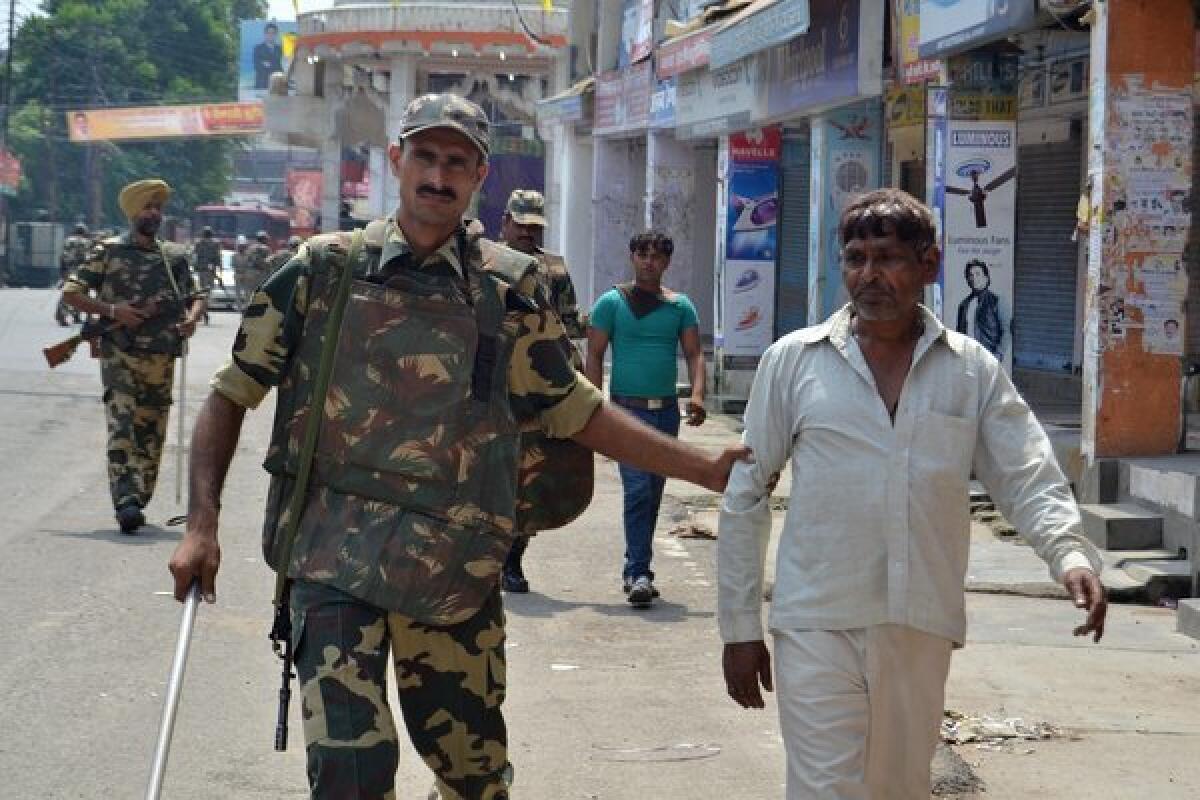An insult grows into violence in India; 31 dead

NEW DELHI -- The death toll from sectarian violence in India’s northern Uttar Pradesh state increased to 31 Monday as police locked down the area and the prime minister called for calm.
A curfew has been imposed, about 13,000 security officers have been deployed to the area and over 100 people were arrested on charges of inciting violence. Schools and shops were closed Monday after hundreds of villagers reportedly fled their homes Sunday or were evacuated by police.
Tensions were sparked in late August when a teenage Hindu girl complained to her family that she’d been verbally harassed by a Muslim boy, also a teenager, in another village in Muzaffarnagar district, located in the northern part of India’s most populous state, according to local media reports.
The girl’s brother and cousin then allegedly went to the boy’s home and shot him dead, at which point members of his family and others in the Muslim community allegedly beat to death the brother and cousin.
Passions were further inflamed when a video was circulated a few days later showing two men being lynched -- in fact, it was reportedly video shot in Pakistan in 2010 -- leading to growing violence in neighboring villages, massive demonstrations, armed street battles and inflammatory speeches by local politicians. Police said rumors spread by mobile phones and social media made the situation worse.
“It began over a trivial issue and turned into communal violence,” said Sharat Pradhan, a Lucknow-based independent political analyst. “This is a common way of settling scores in this part of Uttar Pradesh, which is known as the ‘Wild West,’ a place where human life is almost meaningless.”
Uttar Pradesh’s principal home secretary, R.M. Srivastava, told the state-run Press Trust of India news service that the three-day death toll had reached 31 people as of Monday afternoon. Dr. Ashok Agrawal, Muzaffarnagar’s chief medical superintendent, said his staff has performed 18 postmortems to date, with more expected once the remaining corpses are identified.
“We are waiting for the police orders to decide what to do with the bodies,” he said.
Video from the area showed rows of shops with shutters drawn in Muzzafarnagar as well as empty streets patrolled by army trucks.
Violence between Muslims and Hindus has been an unfortunate feature of Indian politics since the country’s wrenching split with Pakistan in 1947, when hundreds of thousands of people from both communities were killed and millions were displaced.
The latest incidents underscore how sensitive relations remain between different ethnic and religious communities in India. About 80% of India’s 1.2 billion population is Hindu, and around 13% is Muslim.
There have been 451 cases of communal violence so far this year in seven Indian states most prone to Hindu-Muslim violence, according to the results of a study by the Cabinet secretary’s office released Saturday, compared with 410 for all of 2012.
Uttar Pradesh saw some of the most violent religious clashes in recent memory in 1992 after a Hindu mob leveled the 16th century Babri Mosque in Ayodhya. The act of destruction led to weeks of rioting between Hindus and Muslims across India that reportedly left over 2,000 people dead.
Several politicians who’ve tried to reach Muzaffarnagar -- located about 80 miles north of New Delhi -- in recent days have been blocked by police who said their presence threatened to spark more tension. Indian political parties, which frequently stir up religious, ethnic and caste differences to win votes, blamed each other for the violence.
Akhilesh Yadav, the chief minister of Uttar Pradesh and a leader of the Samajwadi Party, blamed the rival Bharatiya Janata Party. Samajwadi tends to rely on Muslim voters, while the BJP is strong among Hindus.
“A minor scuffle between two individuals has been blown into a riot simply because of being fueled by BJP leaders who have nothing else to bank on at a time when general elections are not far away,” Yadav said. BJP leaders have denied fanning sectarian violence.
In a telephone call to Yadav, Prime Minister Manmohan Singh pledged full federal support in stemming the bloodshed and called on the chief minister to take control of the situation and ensure that peace returned to Muzaffarnagar.
A general election is set for early next year. Uttar Pradesh is a hugely important state, and many political leaders are maneuvering for position.
“Because there’s an election around the corner, politicians try and take advantage of it,” Pradhan said. “It’s a game, a blatant political game, with ordinary people held hostage.”
ALSO:
Tens of thousands protest Mexican oil reforms
Kerry presses case for Syria strike, reaffirms bond with Britain
Critics see contradictions in Obama administration’s Syria claims
mark.magnier@latimes.com
Tanvi Sharma in the New Delhi bureau contributed to this report.
More to Read
Start your day right
Sign up for Essential California for news, features and recommendations from the L.A. Times and beyond in your inbox six days a week.
You may occasionally receive promotional content from the Los Angeles Times.






